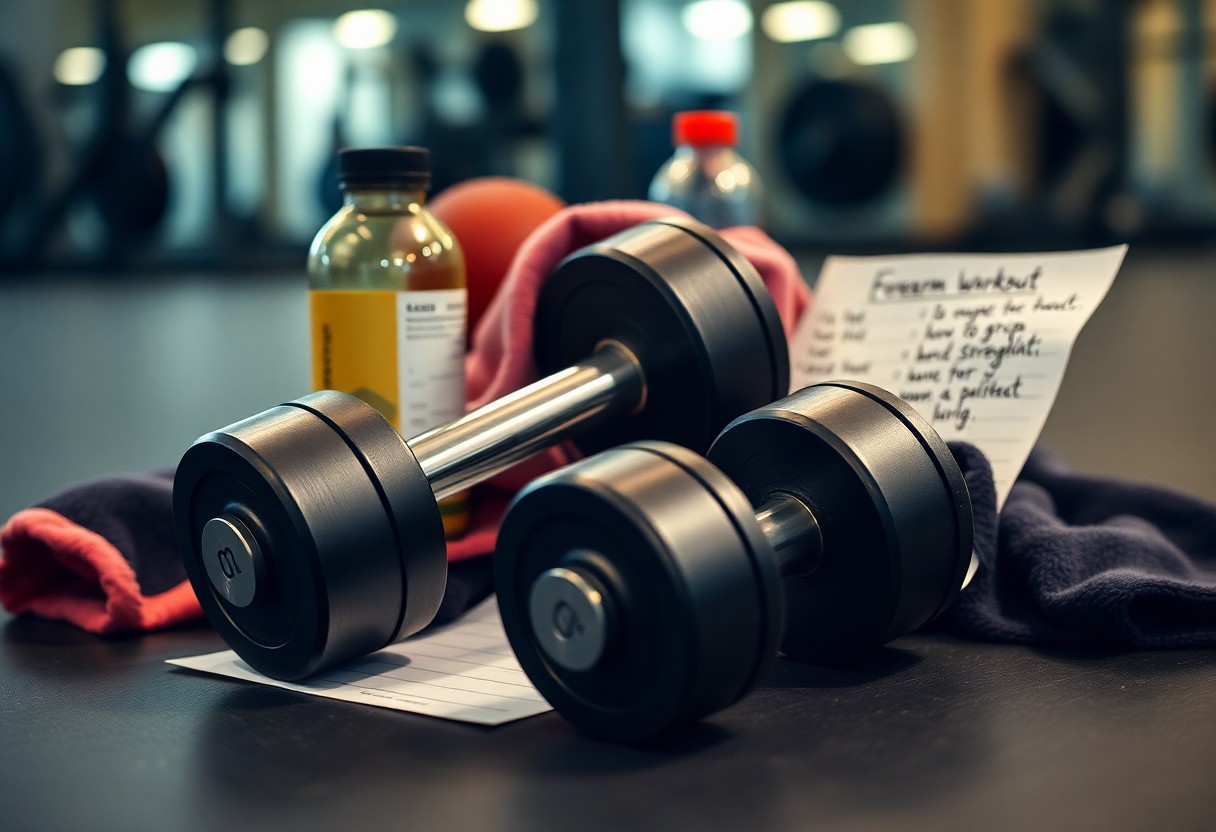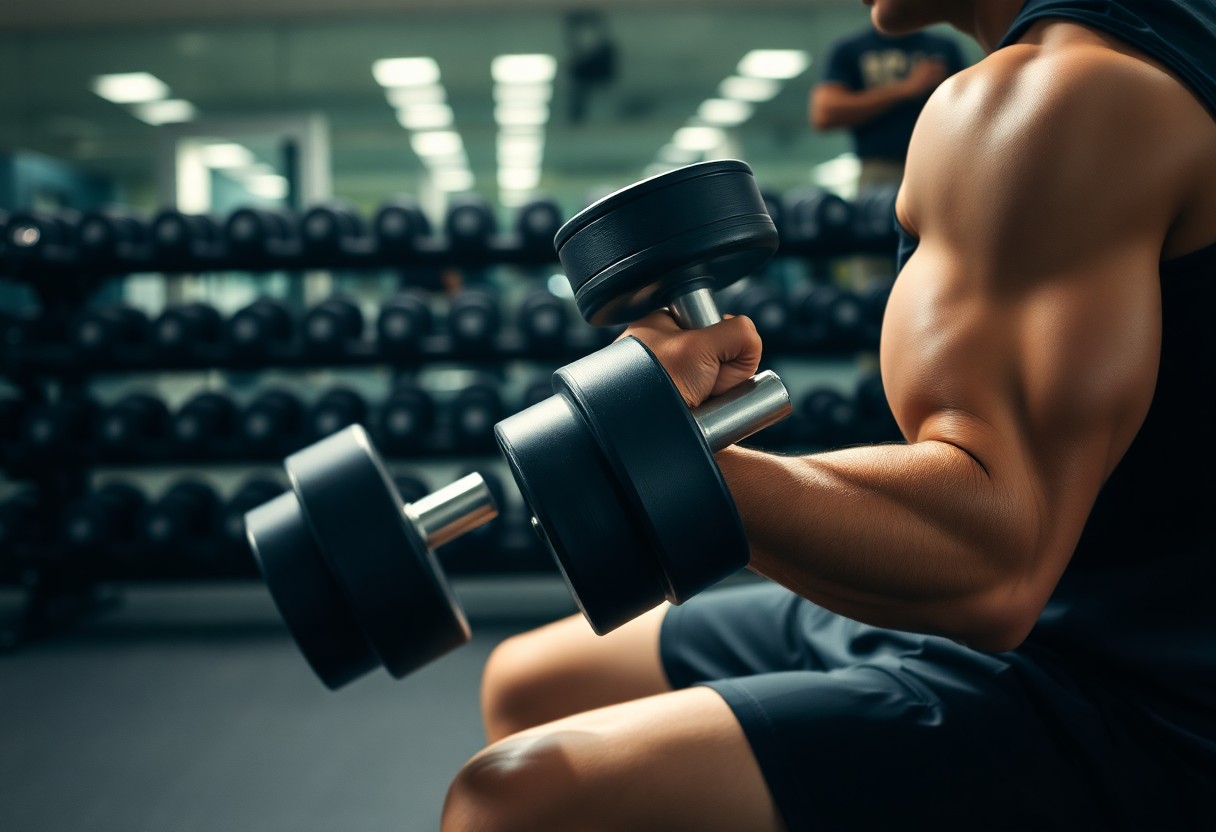Forearm strength is crucial for enhancing overall grip and arm power, whether you’re lifting weights, playing sports, or performing daily activities. By incorporating targeted dumbbell exercises into your routine, you can effectively develop your forearms and improve your performance. Explore the 13 Best Forearm Workouts and Exercises for practical movements that will help you achieve stronger and more powerful arms.

Key Takeaways:
- Incorporating dumbbell exercises enhances grip strength and overall arm power.
- Focus on a variety of movements, including curls, extensions, and wrist rotations, for balanced development.
- Progressively increase weight and resistance to continuously challenge the muscles and promote growth.
Understanding Forearm Anatomy
The forearm consists of two primary bones—the radius and ulna—surrounded by various muscles that facilitate movement and stability. The flexor muscles, located on the anterior side, allow for wrist flexion and grip strength, while extensor muscles on the posterior side enable wrist extension. Understanding this anatomy helps you target specific muscle groups more effectively during workouts, leading to better overall forearm development.
Key Muscle Groups
Your forearm is home to key muscle groups including the flexor carpi radialis, flexor digitorum superficialis, and extensor carpi radialis. These muscles work in tandem to perform actions like gripping, holding, and stabilizing objects. Engaging these muscles through targeted exercises enhances not only your forearm strength but also improves performance in various sports and daily activities.
Importance of Forearm Strength
Forearm strength significantly influences your performance in various athletic pursuits and everyday tasks. A strong grip stabilizes your wrist during heavy lifts, like deadlifts and bench presses, allowing you to lift heavier weights with better control. Additionally, enhanced forearm strength can reduce the risk of injuries by improving joint stability and promoting better posture during physical activities.
In sports, whether you're climbing, playing tennis, or engaging in martial arts, your ability to grip and manipulate equipment relies heavily on forearm strength. Studies show that athletes with well-developed forearm muscles can perform tasks like pulling and pushing more effectively, leading to enhanced performance metrics. Focusing on forearm strength not only equips you for specific sports but also translates into greater functional strength in daily life, making tasks such as opening jars or carrying groceries easier and safer.
Benefits of Dumbbell Workouts for Forearms
Dumbbell workouts specifically target forearms, offering unique benefits including enhanced grip strength and improved muscle coordination. Developing these attributes not only boosts your performance in sports and daily activities but also aids in injury prevention. Incorporating these exercises into your routine can significantly increase your functional strength. For further insights on grip-enhancing techniques, consider exploring Grip Strength Exercises for Stronger Forearms.
Enhanced Grip Strength
Regular dumbbell training effectively builds grip strength, which is important for various activities such as lifting, pulling, and holding objects securely. A strong grip supports better performance in weightlifting and enhances overall athletic capability.
Improved Muscle Coordination
Engaging in dumbbell workouts enhances muscle coordination through the activation of multiple muscles in a controlled manner. This fine-tuning helps your brain establish better communication with your muscles, leading to more efficient movement patterns. For example, as you perform exercises like wrist curls or farmer's walks, the interaction between your forearm muscles and stabilizing muscles increases, contributing to overall athletic performance. Enhanced coordination translates to improved agility, balance, and power in activities ranging from sports to daily chores.
Essential Dumbbell Exercises for Forearms
Dumbbell exercises specifically targeting the forearms can significantly enhance your grip strength and arm development. By including a variety of movements, you can effectively build muscle endurance and power in your forearms, leading to improved performance in various sports and daily activities. Here are some key exercises to incorporate into your routine.
Wrist Curls
Wrist curls are a fundamental exercise for strengthening your wrist flexors. By gripping a dumbbell and curling it upward from a seated position with your forearms resting on your thighs, you isolate and engage the muscles directly. This exercise can be performed with both hands or one at a time for added focus.
Reverse Wrist Curls
Reverse wrist curls effectively target the wrist extensors, balancing your forearm development. Position a dumbbell in each hand with your palms facing down, then curl the weights upward while keeping your forearms stationary. This exercise not only builds strength but also enhances your grip for lifts like deadlifts and pull-ups.
By focusing on the wrist extensors, reverse wrist curls contribute to a more muscular and defined forearm appearance. Incorporate this exercise into your routine to help prevent imbalances and strengthen your entire forearm, which is imperative for improving your overall lifting performance and reducing the risk of injury.
Hammer Curls
Hammer curls are a popular choice for building both bicep and forearm strength. With your palms facing each other, curl the dumbbells up while maintaining a neutral grip. This movement stimulates the brachialis and brachioradialis muscles, effectively increasing forearm mass while also assisting in overall arm size and strength improvement.
Incorporating hammer curls into your workouts can lead to an increase in grip strength, making everyday tasks easier and enhancing your performance in compound lifts. The neutral grip used in this exercise allows for a different type of muscle engagement, making it an excellent addition to your forearm training regimen.
Farmer's Walk
The Farmer's Walk is an excellent functional exercise that integrates grip strength with core stability and overall body power. Carrying heavy dumbbells in each hand while walking a certain distance not only challenges your forearms but also improves your posture and endurance as you stabilize your core throughout the movement.
This exercise mimics real-life situations where you need to carry heavy items, making it not just a strength builder but also a practical addition to your training. Implementing the Farmer's Walk into your routine will enhance your grip strength and overall functional fitness, making daily activities feel easier and more manageable.
Structuring a Dumbbell Forearm Workout
Designing an effective forearm workout with dumbbells involves balancing various exercises to target all areas of your forearms. Integrate movements that emphasize flexion, extension, and rotation for comprehensive development. You can explore the 11 Best Forearm Workouts With Dumbbells to create a diverse and engaging routine.
Workout Frequency
For optimal results, aim to train your forearms 2 to 3 times per week. This allows adequate recovery while still providing enough stimulus for growth. Incorporate forearm exercises into your existing upper body or full-body training regimen.
Repetitions and Sets
Focus on performing 3 to 4 sets of 8 to 15 repetitions for each exercise. This range targets muscle hypertrophy effectively while enhancing endurance. Adjust the weight as necessary to maintain form and prevent injury.
Utilizing this repetition and set range promotes not only strength but also muscle endurance in your forearms. For strength gains, prioritize heavier weights with lower repetitions, while lighter weights and higher repetitions are beneficial for endurance training. Varying your approach every few weeks will prevent plateaus and keep the workouts engaging.
Common Mistakes to Avoid
Avoiding common mistakes during forearm workouts can significantly enhance your results and prevent injuries. Some of the most frequent errors include overtraining, improper form, and neglecting recovery. Pay attention to these pitfalls to ensure that your strength training is both effective and safe.
Overtraining
Overtraining occurs when you push your forearm muscles beyond their recovery capacity, leading to diminished performance and increased risk of injury. You may experience fatigue, decreased strength, and even prolonged soreness. Balancing your training schedule with adequate rest days is crucial for achieving optimal grip strength without burnout.
Improper Form
Using improper form during forearm exercises not only diminishes the effectiveness of the workout but also increases the risk of injury. Suboptimal technique can lead to muscle imbalances and strain on joints, especially in exercises like wrist curls or reverse curls. Concentrate on maintaining a neutral wrist position and controlled movements to engage the right muscle groups effectively.
Improper form can manifest in several ways, such as lifting weights that are too heavy, swinging the dumbbells, or failing to engage the forearm muscles adequately. For instance, during wrist curls, if your wrists are hyperextended or flexed excessively, you risk placing undue stress on the joints, which could lead to chronic pain. Engaging in slow, focused repetitions will allow you to build strength progressively while maintaining integrity in your movements. Regularly check your form in the mirror or consider recording your workouts to identify and correct any flaws. This attention to detail can significantly enhance your gains and minimize injury risk.

Tracking Progress
Tracking your progress in forearm workouts not only keeps you motivated but also provides valuable insights into your strength development. Use a training log to record your exercises, weights, sets, and reps. Include notes on how you feel during each session, as well as any improvements in your grip strength and endurance. This data allows you to identify trends, adjust your workouts accordingly, and celebrate your milestones as you build grip and arm power over time.
Measuring Grip Strength
Measuring grip strength offers a clear indicator of your improvement in forearm workouts. Use a hand dynamometer, which provides an objective measurement in pounds or kilograms. Testing your grip regularly gives you quantifiable data to assess your progress, making it easier to adjust your training regimen for optimal results.
Setting Achievable Goals
Setting achievable goals is key to maintaining motivation and ensuring consistent progress. Establish specific, measurable targets based on your current grip strength and desired outcomes. For example, aim to increase the weight you can lift for a particular exercise by 5% over the next month. Break larger goals into smaller milestones, such as successfully completing a certain number of reps at a specific weight before aiming higher.
Incorporating short-term objectives into your routine enhances your focus. If you currently perform wrist curls with 15 pounds for 10 reps, challenge yourself to do 12 reps by next week or increase to 20 pounds by the end of the month. These incremental advancements create a sense of achievement, ensuring a steady upward trajectory in your training while helping you avoid frustration and burnout.
Conclusion
To wrap up, incorporating forearm workouts with dumbbells into your strength training routine is vital for enhancing your grip and overall arm power. By consistently targeting the forearms with various exercises, you not only improve your functional strength but also increase your performance in other lifts and activities. Commit to these workouts, and you'll notice enhanced stability and strength in your daily tasks and athletic endeavors. Embrace the challenge, and watch your fitness progress thrive.
FAQ
Q: What muscles do forearm workouts with dumbbells target?
A: Forearm workouts primarily target the muscles involved in flexion and extension, including the wrist flexors, wrist extensors, and brachioradialis, helping to strengthen grip and improve overall arm power.
Q: How often should I do forearm workouts with dumbbells?
A: It is recommended to perform forearm workouts 2-3 times a week, allowing for adequate recovery between sessions to promote muscle growth and avoid overtraining.
Q: What are some effective dumbbell exercises for forearms?
A: Effective dumbbell exercises for forearms include wrist curls, reverse wrist curls, hammer curls, and farmer's walks, all of which enhance grip strength and forearm development.
Q: How many repetitions and sets should I aim for in my workout?
A: Aim for 3-4 sets of 8-12 repetitions for each exercise, adjusting the weight as needed to maintain proper form while promoting muscle fatigue by the final reps.
Q: Can I incorporate forearm workouts into a full-body routine?
A: Yes, forearm workouts can be included in a full-body strength training routine, enhancing overall performance and grip strength for other exercises such as deadlifts, pull-ups, and bench presses.







0 Comments